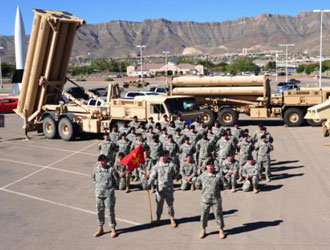The threats spewing forth from Pyongyang are shrugged off by most South Koreans but provide excellent cover for the US to beef up its military presence around the far more significant and realistic flashpoint — the Senkakus (Diaoyudao).
As I’ve suggested in earlier essays, if Pyongyang and the Kim Dynasty didn’t exist, a regime very much like it would have been created out of whole cloth by tacit understanding between Washington and Beijing. The rogue state’s predictably provocative rhetoric and occasional actions keep the fires of militarism, geopolitical ambition and industrial profits well stoked in both the US and the Chinese military-industrial complexes.
Kim’s most recent pronouncement was something like an “approval for a merciless attack on the US”. That prompted the Pentagon to deploy yet another hi-tech showpiece — THAAD, short for Terminal High Altitude Area Defense System.
No doubt the system is a technological marvel and cost well into the billions of dollars. Where better to deploy it than on Guam, Washington’s westernmost possession in the Pacific, right in China’s front yard? Given THAAD’s spec of shooting down short- and medium-range ballistic missiles, where better to deploy it than where it can stop missiles from the only nation in the region with plenty of nuclear missiles?
I don’t mean N. Korea.
What better diplomatically-acceptable rationale to justify deploying THAAD in China’s neighborhood than repeated threats of all-out war by a neighboring regime that has proven that it possesses at least the rudimentary building blocks for a missile capable of reaching Guam, possibly even one with a small nuclear warhead. The fact that it probably doesn’t have a miniature nuke — or even a conventional warhead — capable of actually doing damage to a target at that distance is a matter of academic debate, not for military strategists seeking a pretext for deploying a system to block Chinese missiles targeting Hawaii, a US aircraft carrier or perhaps even the US mainland.
The only plausible trigger for all-out war between China and the US would be a direct attack by China on Japanese territory. The most likely candidate would be the uninhabited group of islets that sit between Okinawa, Taiwan and the Chinese mainland that have already been the cause of so much ink and pixels these past eight months.
The deployment of THAAD comes on the heels of a long string of deployments by the US in response to Pyongyang’s recent string of farfetched threats — an Aegis destroyer, an aircraft carrier, a pair of B-2 bombers, B-52s and a squadron of F-22 stealth fighters with nuclear capability, not to mention a second destroyer on the way and possibly a second aircraft carrier as well.
That kind of arsenal isn’t being deployed to deal with Kim Jong-un, or even to scare Kim; it’s being deployed because Kim has provided a diplomatically defensible pretext to deploy it in East Asia without making the US look like a warmonger. And without violent protests from S. Koreans like the ones that forced the US to withdraw nuclear missiles from the peninsula in the 1990s.
Of course Beijing is well aware of this. Even as Xi Jinping and other officials call for Pyongyang to stop raising tensions in the region, they aren’t objecting to the US buildup. For one, the plausible rationale Pyongyang is providing the US for boosting its Asian military presence spares China loss of face. More importantly, the whole circus happens to play right into Beijing’s own agenda — distracting the world and its own people from its domestic troubles, its own massive military buildup and the rapid acquisition of overseas bases for its mushrooming navy.
Beijing aims to challenge the US in the Middle East, and India in the Indian Ocean, and has taken big strides to do both by adding aircraft carriers, submarines, long-range military cargo planes, and new bases in the region. Facing a slowing economy and a population increasingly restive about official corruption and a widening wealth gap, it welcomes the unfolding N. Korean drama and the US reaction to it as an opportunity to solidify nationalistic sentiment on the part of the average citizen who might otherwise be grousing about the government. And of course, as in the US and elsewhere, the buildup of hi-tech armaments is the single best way for a government to channel wealth to friendly industrialists.
So even as Washington and Beijing direct stern warnings to Pyongyang, they are appreciative of the remarkable amount of cover that a small impoverished regime can provide for massive military buildups, as well as its salutary impact on national solidarity.
What makes the situation even cozier is that Kim himself understands the role he’s playing among the superpowers. More importantly, he too appreciates the power of a little military drama to tame dissension within his own regime.

